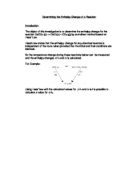- React calcium carbonate with hydrochloric acid.
- React calcium oxide with hydrochloric acid.
In both of these reactions I will measure the enthalpy changes by recording the starting temperature and following the reaction, the end temperature. By following this procedure, I can calculate the change in temperature and consequently the enthalpy change.
The apparatus I will need for these reactions includes:
2 x Polystyrene Cups
250ml Beaker
Digital Thermometer
50ml Measuring Cylinder
I decided to use a polystyrene cup so I could reduce heat loss – polystyrene is an insulator, whereas if I had used glass heat loss would have been a huge influence on results.
I am using a beaker so that when I need to move the reactants, I do not influence any temperature change just through my body heat. Also, the thought of the solution spilling was not a pleasant one, so in case of spillage, the beaker would catch it.
The digital thermometer is much more accurate than a conventional thermometer because it reads down to 1 decimal point.
Safety Apparatus: Safety glasses and lab-coat.
The quantities of materials I have available:
HCl (2.0 mol dm-3) : As much as required
CaCO3 : Between 2.4g and 2.6g
CaO : As much as required
In order to determine the quantities I will need to use in the experiment, I must carry out a few simple calculations. Here is the equation for the first reaction I will carry out, involving CaCO3 and HCl.
CaCO3 + 2HCl → CaCl2 + H2O + CO2
This equation shows that 2 moles of HCl are needed for every 1 mole of CaCO3 to react. Using this information I can calculate the volume of HCl I will need in the reaction. I first need to find the number of moles of CaCO3 will be in the reaction:
Number of Moles = Mass
Relative Formula Mass
No. of moles of CaCO3
100
Now I need to calculate the minimum amount of HCl I will need in the reaction. (Adding more would not affect the results because rate of reaction has no relevance to the experiment. All that is important in this reaction is that it is completed.)
Volume = Moles
Concentration
Volume of HCl
-
0.05 (twice as many as CaCO3, as required)
2
I now know that the quantities I require, in the first experiment, are as follows:
CaCo3 - About 2.5g
HCl - 50cm3 (25cm3 is minimum – any less will affect results)
In the second reaction, involving Calcium Oxide and Hydrochloric acid, the equation is:
CaO + 2HCl → CaCl2 + H2O
Again, like the first reaction, 2 moles of HCl are required to react with 1 mole of CaO.
To keep things simple, I am going to use the same number of moles of CaO as CaCO3.
Mass = Moles x Relative Formula Mass
Mass of CaO needed = 0.025 x 56
Volume of HCl needed
-
0.05 (twice as many as Ca0, as required)
2
In order to carry out these experiments, the following directions should be carried out carefully.
Method for reaction 1: CaCO3 and HCl
-
Add 2.5g of CaCO3 to a polystyrene cup.
- Place the polystyrene cup in a beaker.
-
Add 50cm3 of HCl to a 50ml measuring cylinder.
- Measure the temperature of the HCl.
-
Add the HCl to the CaCO3 and measure the end temperature.
Once I have measured the end temperature I will compare it to the start temperature and calculate the temperature change.
Method for reaction 2: CaO and HCl
- Add 1.4g of CaO to a polystyrene cup.
- Place the polystyrene cup in a beaker.
-
Add 50cm3 of HCl to a 50ml measuring cylinder.
- Measure the temperature of the HCl.
- Add the HCl to the CaO and measure the end temperature.
Again, once I have measured the end temperature I will compare it to the start temperature and calculate the temperature change.
Once the temperature changes have been calculated ΔH needs to be found. Once all of the enthalpy changes have been calculated, follow the equation ΔH1= ΔH2- ΔH3
Risk Assessment
The substances which I am using are both fairly dangerous and have the potential to cause serious damage. Hydrochloric acid can cause burns and is irritating to the respiratory system. The molarity I am using is only irritant but this is still not pleasant. The only form of protection that is really needed while using HCl is to wear safety glasses.
Calcium oxide causes burns and is irritating to the eyes, skin and respiratory system. Again, only eye protection is really needed with the use of this substance.
By using my plan, I expect to get accurate and consistent results as I have calculated the exact amounts of substances needed and factors which will affect results, such as heat loss. Nothing in my experiment will give inaccurate or varied results as long as the method is followed strictly, i.e. correct and precise measurements of substances. The only way the experiment can be inaccurate therefore is through human error.
Sources used in devising my plan:
- Haz-Cards.
- Chemical Ideas, Second Edition – Burton, Holman, Lazonby, Pilling, Waddington.
- Class work notes







